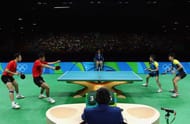The sport of table tennis has come a long from when it began. It started as an after-dinner game played by the upper class during the 19th century. Now, a century later, table tennis is a game that is played worldwide right from recreational players to professionals.
At the Olympics, table tennis comprises five categories namely, men's singles, women's singles, men's team event, women's team event and mixed doubles. In total there will be 70 participants in the men's singles and women's singles event and 16 nations that will compete in the team events.
Mixed doubles is a new event category that has been introduced at the 2020 Olympics. The Olympics is a highly awaited event that makes sports like table tennis even more interesting to watch. But wouldn't watching table tennis at such a prestigious event be more meaningful if you knew a bit more about the rules and formats?
Let's run through the rules, format, and points system.
Format and scoring system | Singles
In the singles competition for both men and women, there will be a knockout stage first which begins with a preliminary round. This is followed by rounds 1-4 which will consist of 16 matches each except for round 4, which will have 8 matches. This will be followed by the quarter-finals, semi-finals, bronze placement round and then the finals.
Each match is played under the best out of 7 formats. Each match will be of 11 points. The first player to win most rounds out of 7 wins. Hence if a player has won 3 matches and his opponent has also won 3, then the 7th and last match is the decider.
In the Olympic format, players who are ranked 33rd to the total number of athletes will enter the competition at the preliminary stage and first round, with seeds 17-32 in the second round. The top 16 athletes who are seeded enter the competition at the third round stage.
After the semi-finals, the two participants who didn't enter the finals will play against each to fight for the bronze medal aka third place.
Format and scoring system | Team Event
Each team will consist of only 3 players. In an event of injury, disqualification or illness of a player, two players can be fielded instead. If an athlete has to pull out for these reasons, the match will be forfeited. But that same player is allowed to play subsequent matches unless he/she is not able to continue. In this situation, two players can be fielded.
In a team event match, there are 5 ties. When either team has won 3 out of those five ties, they win. Here the matches are played using the best of 5 format as opposed to the best of 7 format used in the individual event.
The order of the tie is as follows: first there will be two singles match followed by a doubles match. If till this stage there is no clear winner then two more singles matches are played.
The captain of the teams makes important decisions like who will play the opening two singles matches and the doubles match. But if the last two singles matches are to be played then, it will be done in such a way to ensure that each player has played a minimum of two matches each. This makes it fair for all the teams and evens out the playing field.
Here too, an initial knockout system will be followed and each team reaching the semi-finals but not the finals will fight for the bronze medal.

Rules
The rules of table tennis are very clear when it comes to international events like the Olympics. Each aspect from the table, to the ball and more, have certain rules within which a match must be played. Knowing these rules will be very beneficial while watching table tennis.
#1 Table
-The dimensions of the rectangular table will be 2.74m long and 1.525m wide. It will be 76cm horizontally above the ground.
-The vertical sides of the table are not allowed to be used for play.
-The table will be divided into 2 equal sides with a net running along the exact centre of the table.
#2 The net
-The net will be suspended by a cord attached to each end of the table using posts which are 15.25cm high.
-The top of the net will rest at 15.25cm above the table.
-The bottom of the net in its entirety will be as close to the table as possible.
#3 The ball
-The ball should be spherical. It should have a diametre of 40mm
-The weight of the ball should be exactly 2.7g
#4 The Racket
-The racket may be of any shape or size. The blade of the racket should be rigid and flat
-The side of the blade that is used for striking the ball should be either made of ordinary pimpled rubber or sandwich rubber. In pimpled rubber, the pimples are on the outside of the blade and in the sandwich rubber, the pimples are on the inside.
-The material covering the blades should not be more than the actual size of the blade. Where the blade ends, the covering should end too.
-The racket blade covering can't be treated with any chemicals or other physical treatment.
#5 Legal Service
-While serving, the ball must be thrown in an upward direction at a height on 16cm (minimum) using a flat palm
-The service will only commence once the ball is lying stationary in the player's flat palm.
-The service contact will never be over the table and should always be behind the table.
-At no point during service can the ball be hidden by any part of the body.
-If during a service the ball hits the net and falls on the opponent's side of the table, it is a let. There is no limitation to the number of times this can happen. The player has to re-serve.
